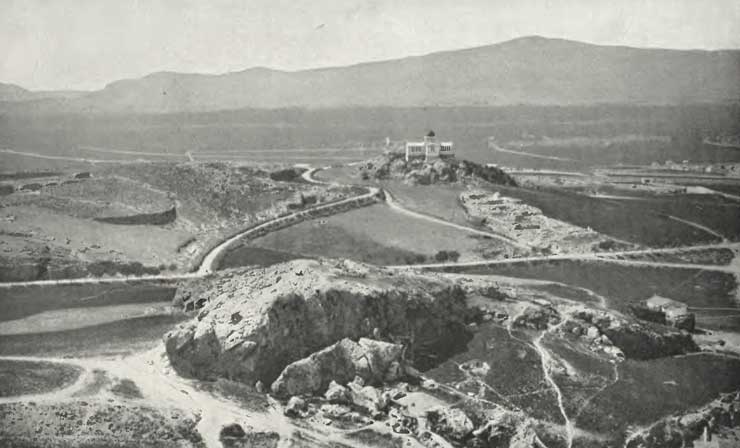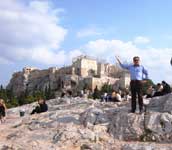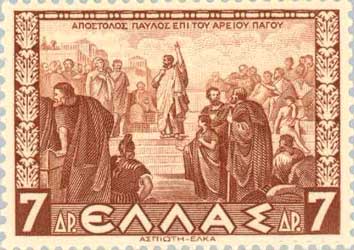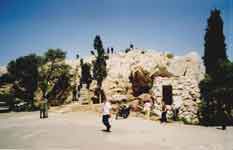.

Hill of Ares, view from the Acropolis
The Areopagus or Areios Pagos is the 'Hill of Ares', north-west of the Acropolis, which in classical times functioned as the chief homicide court of Athens. Ares was supposed to have been tried here by the Gods for the murder of Poseidon's son Alirrothios: a typical example of an aetiological myth. Another legend states that the hill was the site of the trial of Orestes for killing his stepmother and her lover, Clytemnestra and Aegisthus; this is the basis for The Oresteia of Aeschylus.
The origin of its name is not clear. In Greek, pagos means big piece of rock. Areios could have come from Ares (Latin Mars), the Greek god of war, or from the Erinyes (Furies). On its foot was erected a temple dedicated to the Erinyes where murderers used to find shelter so as not to face the consequences of their actions. Near the Areopagus was also constructed the basilica of Dionysius Areopagites.
In pre-classical times (before the 5th century BC), the Areopagus was the council of elders of the city, like the Roman Senate. Like the Senate, its membership derived from those who had held high public office, in this case that of Archon. In 462 BC, Ephialtes put through reforms which deprived the Areopagus of almost all its functions except that of a murder tribunal.

In an unusual development, the Areopagus acquired a new function in the 4th century BC, investigating corruption, although conviction powers remained with the Ecclesia.

The Areopagus, like most city-state institutions, continued to function in Roman times, and it was at that location that the Apostle Paul delivered his famous speech:
Acts 17:22-31 (King James Version)
22 Then Paul stood in the midst of Mars' hill, and said, Ye men of Athens, I perceive that in all things ye are too superstitious.
23 For as I passed by, and beheld your devotions, I found an altar with this inscription, to the Unknown God. Whom therefore ye ignorantly worship, him declare I unto you...
The term "Areopagus" also refers to the judicial body of aristocratic origin, the power of which was enhanced by Solon, or the higher court of Greece.
Pausanias:
There is also the Hill of Ares, so named because Ares was the first to be tried here; my narrative has already told that he killed Halirrhothius, and what were his grounds for this act. Afterwards, they say, Orestes was tried for killing his mother, and there is an altar to Athena Areia (Warlike), which he dedicated on being acquitted. The unhewn stones on which stand the defendants and the prosecutors, they call the stone of Outrage and the stone of Ruthlessness.
| Ancient Greece
Science, Technology , Medicine , Warfare, , Biographies , Life , Cities/Places/Maps , Arts , Literature , Philosophy ,Olympics, Mythology , History , Images Medieval Greece / Byzantine Empire Science, Technology, Arts, , Warfare , Literature, Biographies, Icons, History Modern Greece Cities, Islands, Regions, Fauna/Flora ,Biographies , History , Warfare, Science/Technology, Literature, Music , Arts , Film/Actors , Sport , Fashion --- |
Retrieved from "http://en.wikipedia.org/"
All text is available under the terms of the GNU Free Documentation License



